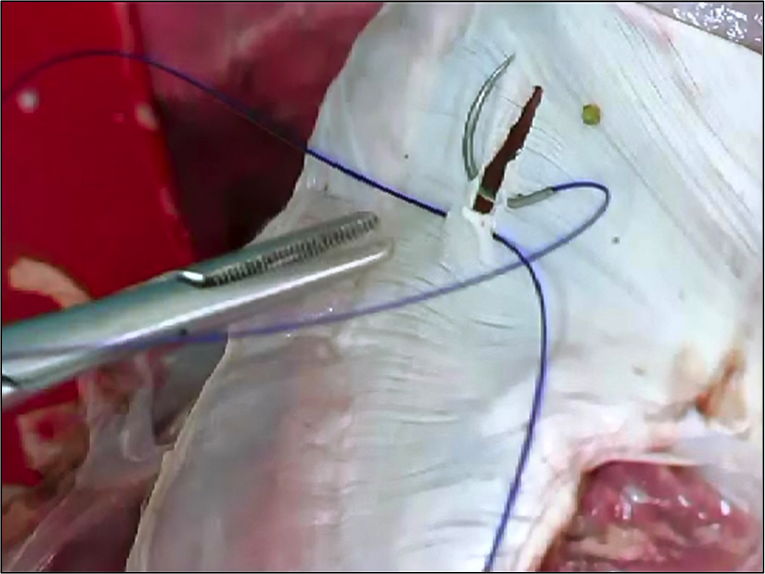Goals
- Compare and contrast the management of the acute and chronic rupture of the diaphragm. In the acute setting, the transabdominal approach is best because of the high likelihood of associated injury to other abdominal organs. If there is a delayed recognition of diaphragmatic rupture, the transthoracic approach is often indicated because concurrent abdominal organ injury is unlikely and adhesions of the herniated abdominal viscera to intrathoracic structures are often present.
- Demonstrate closure of a diaphragm laceration with an initial row of horizontal interrupted mattress sutures followed by a running interlocking suture over the first layer of interrupted sutures.
- Learn how to do the repair with the assistant changing the plane of the diaphragm from a vertical plane to an oblique plane.
Equipment
- Goat mediastinal tissue block. Fresh from local abattoir. Refrigerate. Consists of heart, lungs, esophagus, trachea, diaphragm, thoracic aorta and esophagogastric junction with attached proximal one third of the stomach.
- Scalpel with #10 blade.
- Surgical forceps.
- 0-Ethibond or other size non-absorbable suture.
- Straight or curved hemostat.
- Two Kelly clamps.
- Suture scissors.
- Needle holder.
- Spool of heavy twine.
Preparation
- Attach the mediastinal tissue block to the cutting board with heavy twine passed through the proximal esophagus and trachea. Do not obstruct the esophageal lumen. Tie this suture around the screw at the end of the cutting board. Place a second heavy twine through the distal diaphragmatic crura and tie around the screw at the distal end of the cutting board.
- Grasp the anterior edge of the diaphragm with two Kelly clamps and pull up to display the diaphragm surface.
- Make a 3 cm incision in the diaphragm.
Discussion
Transabdominal Repair of an Acutely Ruptured Diaphragm
1. Grasp the edge of the diaphragm laceration and place a horizontal mattress suture of 0-Ethibond. Repeat with interrupted mattress sutures until the laceration is closed.

Figure 6-1: Ruptured Diaphragm Repair – Horizontal Mattress Suture
2. For the second layer, place a 0-Ethibond continuous interlocking suture along the entire length of the repair. This serves to reinforce the repair and enhance hemostasis.
Video Exercise 6.1
Exercise 6-1 Repair Ruptured Diaphragm
Videos may take a moment to load depending on your connection speed.
Video Exercise 6.2
Exercise 6-2 Interlocking Sutures – 2nd Layer
Videos may take a moment to load depending on your connection speed.